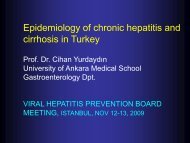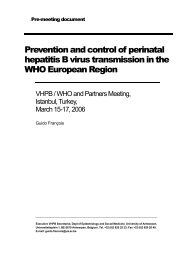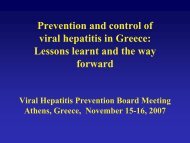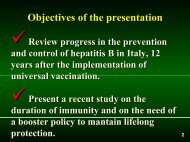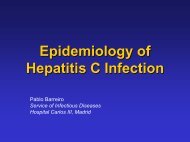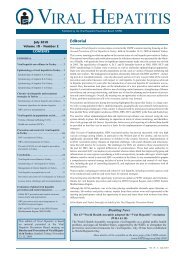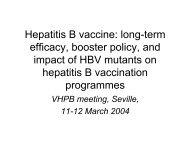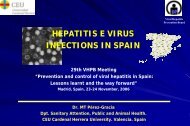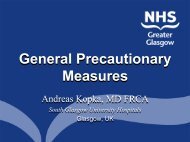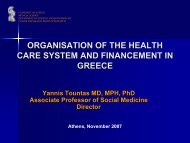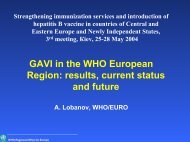Molecular epidemiology of HCV - Viral Hepatitis Prevention Board
Molecular epidemiology of HCV - Viral Hepatitis Prevention Board
Molecular epidemiology of HCV - Viral Hepatitis Prevention Board
You also want an ePaper? Increase the reach of your titles
YUMPU automatically turns print PDFs into web optimized ePapers that Google loves.
MOLECULAR EPIDEMIOLOGY OF <strong>HCV</strong>
RNA<br />
dependent<br />
RNA<br />
polymerase<br />
RNA RNA<br />
LACK OF PROOFREADING MECHANISMS<br />
Mutation rates (mutations / nucleotide / cicle <strong>of</strong> replication)<br />
F.Penin et al Hepatol 2004;39:5-19<br />
10 -3 -10 -5<br />
Exemple: 10 4 nts and mut.rate <strong>of</strong> 10 -4<br />
= 1 mutation/new genoma
QUASISPECIES NATURE OF <strong>HCV</strong><br />
Mutant spectrum<br />
Master sequence<br />
Consensus sequence
Quasispecies diversity, pathogenesis and cooperative interactions<br />
Wild type<br />
RBV resistant mutant<br />
C P2 P3<br />
C P2 P3<br />
G64S<br />
C P2 P3<br />
IV inoculation<br />
Isolation tissues<br />
C P2 P3<br />
G64S<br />
IV inoculation<br />
Isolation tissues<br />
C P2 P3<br />
+<br />
C P2 P3<br />
G64S<br />
IV inoculation<br />
Isolation brain<br />
RT-PCR<br />
Sac digestion<br />
Vignuzzi M, et al. Nature 2005
RATE OF FIXATION OF MUTATIONS (mutations/site/year) (x10 -3 )<br />
5'UTR<br />
1,06 2,12 2,7 2,05 1,33 0,41 1,39<br />
C E1 E2 p7<br />
2 3 4<br />
4B 5A 5B<br />
A<br />
3'UTR<br />
2,94<br />
STRUCTURAL<br />
NON STRUCTURAL<br />
Genotyping<br />
<strong>Molecular</strong><br />
<strong>epidemiology</strong> studies
COMPARATIVE GENETIC DISTANCE<br />
Nucleotides Amino acids<br />
Genotypes (Consensus. All genome): 31-34% 30%<br />
Subtypes (Consensus. All genome): 20-23%<br />
Pawlotsky JM, Trends Microbiol 2004; 12:96-102<br />
Quasispecies (Cloning. E1/E2) 10%<br />
With Source <strong>of</strong> infection(Consensus. E2-PePHD) 1%
TRANSMISSION MECHANISMS OF <strong>HCV</strong><br />
A. PARENTERAL:<br />
1. Percutaneous:<br />
• Transfusion<br />
• Plasma product recipients (haemophiliacs, recipients <strong>of</strong> platelet<br />
concentrates, IVIG)<br />
•Organ transplantation<br />
2. Nosocomial (Patient-to-patient, Haemodialysis patients...)<br />
3. IVDU<br />
B. NON-APPARENT PARENTERAL:<br />
1. Health-care workers<br />
2. Tattooing, Acupuncture.<br />
C. NON-PARENTERAL:<br />
1. Mother-to-infant<br />
2. Sexual and household transmission
MOLECULAR EPIDEMIOLOGY STUDY<br />
A. Epidemiologic investigation:<br />
A1- Confirmation <strong>of</strong> <strong>HCV</strong> infection and genotyping.<br />
A2- On-site review <strong>of</strong> risk factors, diagnostic procedures, surgical<br />
interventions, medications and other treatments, interview with the<br />
health-care workers. Serological testing <strong>of</strong> patients undergoing the<br />
procedure before and after the patient<br />
B. <strong>Molecular</strong> analysis <strong>of</strong> viral isolates (source-recipient):<br />
1- Samples from patients and potential viremic sources<br />
2.-RNA extraction<br />
3.-RT-Nested-PCR<br />
4.-Sequencing<br />
5.-Phylogenetic analysis
PHYLOGENETIC<br />
ANALYSIS<br />
GENETIC DISTANCE:<br />
Percentage differences between the<br />
same genomic is a measure <strong>of</strong><br />
“genetic distance” between these<br />
nucleotide sequences.<br />
PHYLOGENETIC TREES<br />
Graphic representation <strong>of</strong> homology<br />
(or distance) among various species.<br />
It has a form <strong>of</strong> cladogram.<br />
Each node with descendants<br />
represents the most common ancestor<br />
<strong>of</strong> the descendants, and the edge<br />
lengths correspond to time estimates.<br />
http://evolution.genetics.washington.edu/phylip/s<strong>of</strong>tware.html
SEXUAL<br />
TRANSMISSION
SEXUAL TRANSMISSION<br />
PATIENT<br />
August 1998. Acute infected patient. JAUNDICE.<br />
DIAGNOSIS<br />
<strong>HCV</strong> + G1a<br />
SOURCE OF INFECTION<br />
HISTORY<br />
MEDICAL<br />
RECORD<br />
She was a blood donor. <strong>HCV</strong> negative in December 1997<br />
On-site review <strong>of</strong> risk factors, diagnostic procedures, surgical<br />
interventions, medications and other treatments<br />
CONCLUSION<br />
No risk other than being sexual partner <strong>of</strong> a chronic infected patient.<br />
G<br />
1<br />
a<br />
H<br />
C<br />
V<br />
+
PHYLOGENETIC TREE E2-PePHD. SEXUAL TRANSMISSION<br />
(Consensus sequence analysis).<br />
HC-J1<br />
<strong>HCV</strong>1<br />
938<br />
Q1a<br />
663<br />
LC3<br />
455<br />
LC4<br />
LC2<br />
1000<br />
937<br />
LC1<br />
707<br />
MAN<br />
998<br />
100<br />
WOMAN<br />
Quer et al. Sex.Transm.Dis. 2003; 30:470-471
PHYLOGENETIC ANALYSIS. Consensus and clonal sequences from patient A<br />
(chronic) and B (acute and self-recovering)<br />
1000<br />
A-10/1993<br />
9950<br />
6971<br />
A-1/1996<br />
A-10/1997<br />
4604<br />
4776<br />
9704<br />
7071<br />
9636<br />
3703<br />
A4<br />
9564<br />
9997<br />
Quer J, et al. J Virol 2005; 79:15131-41<br />
B1<br />
B4<br />
3153<br />
B2<br />
B10<br />
A3<br />
B7<br />
B-9/1998<br />
B3<br />
B12<br />
B5<br />
B8<br />
B6<br />
B11<br />
B9<br />
4467<br />
3817<br />
A5<br />
7654<br />
6234<br />
A11<br />
A9<br />
A-5/2001<br />
7858<br />
Patient A<br />
Patient B<br />
A2<br />
A1<br />
A-10/1998<br />
A10<br />
7601<br />
7444<br />
Patient B clones<br />
(WOMAN)<br />
A6<br />
8288<br />
class II: DR1, DR15; DR51; DQ5, DQ6;<br />
class I: A2, A28; B7, B14; Cw7, Cw8<br />
class II: DR4, DR11; DR52; DR53; DQ3;<br />
class I: A66, A69; B41, B55; Cw1<br />
Patient A clones<br />
(MAN)<br />
A12<br />
A8<br />
A7<br />
Similar viral yield
When BOTTLENECKING / Evidences.<br />
Genetic BOTTLENECK might operate in circumstances in which <strong>HCV</strong><br />
transmission occurs through exposure to very small inoculum:<br />
-Sexual contact:<br />
•Detected intermittently in semen<br />
•Low viral load: 85% <strong>of</strong> cases 80%
NOSSOCOMIAL<br />
patient-to-patient<br />
TRANSMISSION
PATIENT<br />
CTA<br />
June/July 2004, patient CTA underwent clinical procedures.<br />
<strong>HCV</strong> negative at that time.<br />
August 2004. Acute hepatitis patient with nausea,<br />
fatigue and jaundice.<br />
<strong>Hepatitis</strong><br />
A1- VIRUS, GENOTYPE ANALYSIS<br />
<strong>HCV</strong> +<br />
G1b
A2- SOURCE OF INFECTION<br />
Department <strong>of</strong> Preventive Medicine and Epidemiology<br />
Epidemiological Service. Public Health Agency <strong>of</strong> Barcelona.<br />
Department <strong>of</strong> Health Generalitat de Catalunya<br />
MEDICAL RECORD OF THE<br />
PATIENT WAS REVIEWED<br />
He underwent an ENDOSCOPY with<br />
BIOPSY, 7-8 weeks before. The previous<br />
endoscopied patient was chronic <strong>HCV</strong>+.<br />
G<br />
1<br />
b<br />
V<br />
H<br />
C<br />
ENDOS<br />
+
1. RNA EXTRACTION<br />
SERUM<br />
VIRAL RNA<br />
2. RT-NESTED-<br />
PCR<br />
PCR<br />
Agarose gel<br />
PM<br />
PM<br />
Fragment<br />
650 pb<br />
Fragment<br />
200 pb<br />
Real-time PCR
3. SEQUENCING<br />
310 Genetic Analyzer 24/24 hours , 7/7 days<br />
capilar<br />
LÁSER<br />
ventana<br />
migración
ENDOSCOPY<br />
G1b<br />
X1BENO<br />
235<br />
1000 224<br />
22<br />
65<br />
185<br />
11<br />
13<br />
14<br />
4<br />
89<br />
164<br />
251<br />
250<br />
487<br />
X1BKOR<br />
1000<br />
SR1bPR9<br />
X1BOKA<br />
NR1bPR7<br />
X1BXIN<br />
X1BAIZ<br />
NR1bRb2<br />
NR1bPR1<br />
X1BTAK<br />
NR1bNULL6<br />
X1BAUST<br />
XAUS2<br />
CHRONIC <strong>HCV</strong>+ ENDOSCOPY<br />
NR1bNULL2<br />
SR1bRVR3<br />
X1BGRM<br />
LC17<br />
ACUTE INFECTED<br />
ENDOS<br />
CTA1<br />
6<br />
100<br />
76<br />
119<br />
3<br />
262<br />
21<br />
75<br />
171<br />
442<br />
400<br />
290<br />
NR1bNULL7<br />
NR1bNULL1<br />
NR1bNULL5<br />
SR1bPR4<br />
989<br />
SR1bRVR10<br />
SR1bRVR21<br />
X1BHON<br />
SR1bRVR5<br />
LC14<br />
LC18<br />
LC19<br />
SR1bPR8<br />
GENETIC DISTANCE:<br />
CTA1-LC / CTA1-Genbank= 7.8-14.7%<br />
CTA- ENDOS = 12.4%
CTA patient, also underwent a Contrast-<br />
Enhanced Computed Tomography scan 7 weeks<br />
before jaundice.<br />
The previous scanned patient was <strong>HCV</strong>+.<br />
G<br />
1<br />
b<br />
V<br />
H<br />
C<br />
+
Contrast-enhanced CT<br />
100<br />
G1b<br />
X1BENO<br />
235<br />
1000224<br />
22<br />
65<br />
185<br />
11<br />
13<br />
14<br />
164<br />
487<br />
89<br />
251<br />
4<br />
6<br />
3<br />
76<br />
21<br />
75<br />
250<br />
119<br />
262<br />
442<br />
400<br />
171<br />
290<br />
X1BKOR<br />
1000<br />
SR1bPR9<br />
X1BOKA<br />
NR1bPR7<br />
X1BXIN<br />
X1BAIZ<br />
NR1bRb2<br />
NR1bPR1<br />
X1BTAK<br />
NR1bNULL6<br />
EBA0105<br />
NR1bNULL2<br />
SR1bRVR3<br />
X1BAUST<br />
XAUS2<br />
X1BGRM<br />
LC17 ACUTE PACIENT<br />
1000<br />
1000<br />
NR1bNULL7<br />
NR1bNULL1<br />
NR1bNULL5<br />
SR1bPR4<br />
989<br />
SR1bRVR10<br />
SR1bRVR21<br />
X1BHON<br />
SR1bRVR5<br />
LC14<br />
LC18<br />
LC19<br />
1000<br />
SR1bPR8<br />
CTA1<br />
CHRONIC CT SAMPLE AUGUST<br />
CHRONIC CT NOVEMBER<br />
CHRONIC CT DECEMBER.<br />
GENETIC DISTANCE:<br />
CTA1-LC / CTA1-Genbank = 7.8-14.7%<br />
CTA1- TAC = 0.6%<br />
TAC
MULTI-DOSE CONTRAST MEDIUM EQUIPMENT<br />
500 mL<br />
Contrast vial<br />
injector<br />
Extender lines<br />
Perfusion equipment<br />
Patient<br />
Three-way connector<br />
Anti flow-back valve
MOLECULAR EPIDEMIOLOGY. Conclusions<br />
• To identify a source <strong>of</strong> infection<br />
• To establish transmission mechanisms<br />
• To modify procedures to prevent additional infections through<br />
nosocomial transmission:<br />
Patient-to-patient specially by using multidose vials<br />
During haemodialysis<br />
Infection to health-care-workers<br />
Health-care provider-to-patient transmission<br />
It has legal, economical and medical practice<br />
implications:<br />
• liability <strong>of</strong> health-care providers<br />
• economical compensation to patients infected in the health-care setting<br />
• potential restrictions to <strong>HCV</strong>-infected medical practitioners involved<br />
in invasive procedures.





